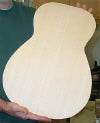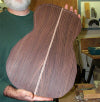A Pictorial Review
by Ken & Trisha Brooks
This was our first attempt at building a resophonic guitar.We thought you might enjoy the pictures and maybe learn from our experience.
This guitar had an incredible sound but we felt it could have used more bracing as it was made of thin solid woods. You will see, in the last two pictures, that extra bracing was added after the guitar suffered an accident which resulted in a cracked top.
Click any picture for a larger view

A solid spruce top cut to shape
|

Book matched rosewood back with exotic wood inlay
|

Bending a rosewood side
|

The bent side being made to conform to a mold
|

Checking placement of soundwell and braces
|
|

Setting the location of back braces.
The plywood form
underneath is the work board
|

Gluing the braces
|

Finished back with braces
|

A glue kerfing is added to
the soundwell to give more gluing surface
|

More kerfing being clamped
on with clothespins
|
|

In this shot,
both the neck and tail blocks
are glued and clamped in place
|

Kerfing is added to
rosewood side
|

Kerfing gives more area
for the glue to hold on the top
and back plates
|

Checking the first side
for fit before gluing
|

Many clamps make
for even pressure.
We made these clamps
before starting the guitar
|
|

The glued side
seen from the inside
|

Fitting the second side
|

Glue and clamps
to hold it together
|

Cleaning out glue
|

Sides, soundwell and end blocks
are leveled with a
large sanding board
|
|

It took a lot of sanding
and frequent checking
to get everything level
|

Attaching the top.
You can never have
too many clamps!
|

Cleaning out excess glue
|

The wood inlay goes around
both ends of the guitar
Here it is seen at the neck end
|

Another view in which you can
see the top and one of the sound holes
|
|

Using a Dremel
with a binding router attachment
to make a ledge for the binding
|

Here you can see the attachment
on the end of the Dremel tool
|

The binding is glued into the ledge
around the guitar
and clamped in with tape
|

The pieces of strapping tape
hold the binding very well
while the glue dries
|

After routing
the back of the guitar also receives binding
|
|

Now we just wait for the glue to dry
|

The binding needs to be
scraped flush to the
sides of the guitar
|

A cabinet scraper works well for this job
|

For visual clarity,
the fretboard was painted white
then etched where the inlays will go
|

The fretboard is routed to receive the inlays
|
|

Trisha will use a
diamond shaped inlay for this marker
|

She then epoxies the pieces into their holes
and places the board under a heat lamp
|

After the epoxy dries,
the board is sanded to remove excess
paint and epoxy
|

Not Yet. Still more sanding needed
|

The finished inlay work on the fretboard
|
|

Setting fret wires
|

Pressing frets into
final position
with a caul on the drill press
|

Binding is then added
around the fretboard
|

Trisha cuts the
peghead shape
at the band saw
|

Here, she is painting
and etching the headstock
|
|

It's scary business
to have to drill holes in the head
but it needs to be done
|

Does a nice piece of
curly maple really need all these holes?
|

Check many times
before drilling and
make sure everything is secure
|

There, that wasn't too bad
|

Trisha works some magic
with the router
|
|

The router base attachment
that fits the Dremel tool
does a nice job for inlays
|

Now she messed it up
with that goop
|

Black epoxy is used
to set the inlays
|

A heat lamp is used
to cure the epoxy
|

Ugh, yech!
|
|

She says
she can fix it
|

I don't
know..........
|

Back to the
old sanding board
|

I knew she
could do it
|

This is the jig used
to drill neck holes.
The drill is an old
Craftsman radial press
|
|

Checking to see if
the neck bolts will fit
|

Using the a fine adjuster
(don't try this at home)
|

After some finish work
the parts were
hung out to dry
|

Here is the finished project
with Quarterman cone,
bone nut
and maple with
ebony capped bridge
|

....and the back
|
After the Accident (guitar dropped on endpin)
|

2 carbon fiber rods and an extra tail block were added for longitudinal strength. (holes in the soundwell needed to be widened) After the epoxy set, the rods were plucked and gave off a G# pitch. That couldn't be good...........
|

...so, posts were added to break up the ringing length of the rods which adds more support to the back.
|








































































